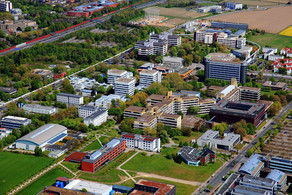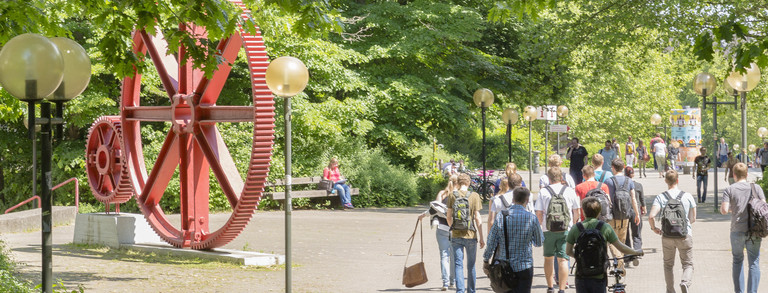Greenhouse Gas Emissions
The activities of TU Dortmund University emitted a total of 34742 tCO2 equivalents (tCO2-eq) in 2022. Scope 1 and Scope 2 as well as some Scope 3 emissions are taken into account in this greenhouse gas balance: Scope 1 emissions from in-house energy production (electricity, heating, cooling), Scope 2 emissions from purchased energy sources (electricity, heating, cooling) and Scope 3 emissions resulting from the mobility of TU members (commuting, business trips, semesters abroad). Network losses of 10% are assumed for purchased gas for heat and electricity generation in order to take into account efficiency losses, pipeline losses and unmeasurable losses at the transfer point. Emissions resulting from the production and transportation of purchased goods, construction activities, distribution and use of own products and waste disposal have not yet been taken into account. Greenhouse gas emissions from Mensa are also not included here, as it is operated by Studierendenwerk Dortmund and is not part of TU Dortmund University.
Interactive Graphic. Source: Sustainability Office/TU Dortmund University
An interactive treemap diagram that visualizes TU Dortmund University's CO₂ emissions with rectangles. The individual rectangles represent different categories, with the size of a rectangle reflecting the proportional share of this category in the total emissions value (34742t CO2eq). The main categories are highlighted in color:
(% refer to the share of the total emission value)
- Commuting (gray):
- 35.1 % "Car Students" (12179t CO2eq)
- 10.9 % "Public Transport Students" (3790t CO2eq)
- 8.4 % "Car Staff" (2935CO2eq)
- 1 % "Public Transport Staff" (363t CO2eq)
- Heating (red):
- 26.5% "Heating" (9190t CO2eq)
- Electricity (yellow):
- 8.6% "Electricity" (3002t CO2eq)
- Cooling (blue):
- 3.1% "Cooling" (1079t CO2eq)
- Travel (dark gray):
- 3.8 % "Plane" (1330t CO2eq)
- 1.3 % "Accomodation" (439t CO2eq)
- < 1 % "Abroad Studies" (198t CO2eq)
- < 1 % "Train" (94t CO2eq)
- < 1 % "Car" (75t CO2eq)
- < 1 % "Car Pool" (37t CO2eq)
- Various (magenta):
- < 1 % "Paper" (30t CO2eq)
As can be seen from the figure above, the largest sectors of CO2 emissions at TU Dortmund University are daily commuter traffic (19266 t CO2-eq, light gray), heating and cooling production (10269 t CO2-eq, red and blue) and electricity production from TU Dortmund University's own combined heat and power plant (3002 t CO2-eq, yellow). The emissions from purchased energy sources do not appear in the figure, as the electricity purchased by TU Dortmund University is green electricity and neither heating nor cooling is purchased from outside sources. However, by purchasing green electricity, TU Dortmund University has already been able to reduce its CO2 emissions in the electricity sector by around 8000 t CO2-eq.
Electricity, heating and cooling
In 2022, TU Dortmund University consumed 38.9 GWh (9190 t CO2-eq) of heat, 11.2 GWh (1079 t CO2-eq) of cooling and 36.5 GWh (3002 t CO2-eq) of electricity. Heating and cooling are generated entirely in-house with boilers (Heizkessel, HKW) and a combined heat and power plant (Blockheizkraftwerk, BHKW), while around a third of the electricity is generated internally. TU Dortmund University relies almost entirely on natural gas as a fuel. The electricity purchased is assumed to be emission-free green electricity. Current PV systems supply less than 1% of the total electricity required.
Mobility
In 2022, the members of TU Dortmund University covered a total distance of around 209.9 million km to reach TU Dortmund University or to carry out their official duties. This distance corresponds to around 5,200 circumnavigations of the earth or around 1.4 times the distance between the earth and the sun. The calculated distance is mainly made up of daily commuting (197 million km, 19266 t CO2-eq) and business trips (11.5 million km, 1937 t CO2-eq). In addition, semesters abroad caused around 1.3 million km (198 t CO2-eq). The own vehicle fleet of TU Dortmund University caused 0.2 million km (37 t CO2-eq).
Details commuter traffic
To calculate daily commuter traffic and the associated CO2 emissions, a TU Dortmund University-wide mobility survey was carried out in spring 2023, on the basis of which the emissions for 2022 were calculated retrospectively. The survey with 1470 participants (897 students, 573 employees) showed that 55% (32%) of students (employees) travel to TU Dortmund University by public transport, 39% (58%) by motorized transport and 6% (10%) CO2-free by bicycle or on foot. The survey also revealed that students (employees) commute to TU Dortmund University on 148 (164) days, covering an average distance of 19 (19) km. In order to calculate the emissions caused by commuting for the entire university, the survey results were extrapolated to 32476 students (6857 employees). The number of students (employees) was reduced by 1969 phd students (2058 student assistants) in their dual role as students and employees, so that phd students (student assistants) have the same mobility behavior as employees (students) and are not counted twice.
Interactive Graphic. Source: Sustainability Office/TU Dortmund University
A color-coded thematic map of NRW shows the distribution of commuters based on their place of residence. The cities of the federal state are shown. The colors correspond to a logarithmic scale proportional to the number of residences.
- Dark purple: regions with the highest number of residences (logarithmic value around 3).
- Green to yellow: Regions with medium to low residential density.
- Yellow: Regions with the lowest values (close to 0 on the log scale).
The map shows Dortmund as the central metropolitan region, marked by the darker colors, while the surrounding cities have a lower density.
Exact figures can be found in the following table:
| City/district | Number of residences |
|---|---|
| Dortmund | 802 |
| Bochum | 98 |
| Essen | 48 |
| Witten | 40 |
| Hagen | 33 |
| Kamen | 18 |
| Kamen | 18 |
| Hamm | 17 |
| Recklinghausen | 17 |
| Iserlohn | 16 |
| Castrop-Rauxel | 15 |
| Lünen | 15 |
| Unna | 15 |
| Schwerte | 14 |
| Gelsenkirchen | 13 |
| Duisburg | 10 |
| Waltrop | 9 |
| Wuppertal | 9 |
| Fröndenberg/Ruhr | 8 |
| Münster | 8 |
| Hattingen | 7 |
| Oberhausen | 7 |
| Werne | 7 |
| Arnsberg | 6 |
| Cologne | 6 |
| Menden | 6 |
| Selm | 6 |
| Ennepetal | 5 |
| Lüdighausen | 5 |
| Soest | 5 |
| Werl | 5 |
| Weather | 5 |
| Dates | 4 |
| Dülmen | 4 |
| Ense | 4 |
| Herdecke | 4 |
| Marl | 4 |
| Oer-Erkenschwick | 4 |
| Sprockhövel | 4 |
| Ahlen | 3 |
| Altena | 3 |
| Bönen | 3 |
| Bottrop | 3 |
| Gevelsberg | 3 |
| Gladbeck | 3 |
| Herten | 3 |
| Schwelm | 3 |
| Steinfurt | 3 |
| Ascheberg | 2 |
| Bielefeld | 2 |
| Gütersloh | 2 |
| Halver | 2 |
| Holzwickede | 2 |
| Moers | 2 |
| Remscheid | 2 |
| Anröchte | 1 |
| Balve | 1 |
| Bergkamen | 1 |
| Bochholt | 1 |
| Bonn | 1 |
| Coesfeld | 1 |
| Dinslaken | 1 |
| Enningerloh | 1 |
| Erwitte | 1 |
| Grevenbroich | 1 |
| Haltern am See | 1 |
| Heiden | 1 |
| Heiligenhaus | 1 |
| Heinsberg | 1 |
| Hennef | 1 |
| Herscheid | 1 |
| Kaarst | 1 |
| Kamp-Lintfort | 1 |
| Kierspe | 1 |
| Kirchlengern | 1 |
| Lüdenscheid | 1 |
| Monheim on the Rhine | 1 |
| Neuenrade | 1 |
| Nordkirchen | 1 |
| Olfen | 1 |
| Radevormwald | 1 |
| Ratingen | 1 |
| Rietberg | 1 |
| Sendenhorst | 1 |
| Siegen | 1 |
| Sundern | 1 |
| Verl | 1 |
| Viersen | 1 |
| Voerde | 1 |
| Welver | 1 |
| Wermelskirchen | 1 |
| Wesel | 1 |
| Wilich | 1 |
The emission factors were assumed to be 180 g/CO2-eq (41 g/CO2-eq) for the car (train) (Ritchie 2023, Our World in Data, last accessed 3 March 2024). This results in 197 million commuting kilometers to TU Dortmund University or 19266 t CO2-eq. The different mobility behavior of students and employees results in an annual average emission of 0.52 t CO2-eq per student and 0.73 t CO2-eq per employee.
The majority of survey participants at the university commute from Dortmund or along the Hellweg axis.
Details business trips
To determine the business trips from 2022, the corresponding data was exported anonymously from the central SAP system, elaborately prepared for automatic processing and then analyzed. In total, 9078 business trips with 35057 travel days and a total of 25979 overnight stays were carried out at TU Dortmund University in 2022. In total, the members of TU Dortmund University traveled around 11.5 million km on business trips. Of these trips, 17.4% (1330 t CO2-eq) were made by plane, 57.1% (94 t CO2-eq) by train and 17.5% (74 t CO2-eq) by car. Only 8% of business trips were made digitally. The overnight stays caused emissions amounting to 439 t CO2-eq, assuming that each stay was in a 3-star hotel (16900 g CO2-eq per night, see DEHOGA Bundesverband, provided in German).
Interactive Graphic. Source: Sustainability Office/TU Dortmund University
A thematic world map visualizes the frequency of business trips to different countries. The countries are color-coded based on a scale of the number of trips:
- Yellow: countries with the most business trips (over 200 trips).
- Green to turquoise: Countries with a medium number of trips (between 50 and 200).
- Dark purple: Countries with few or no trips.
The map clearly shows that most business trips are made to highly industrialized countries such as the USA, Germany and other European countries. Regions with little or no travel are predominantly in Africa, parts of Asia and South America.
Exact figures are listed in the following table:
| Country | Number of business trips |
|---|---|
| Switzerland | 233 |
| Italy | 204 |
| France | 191 |
| Austria | 184 |
| United States | 183 |
| Netherlands | 174 |
| Spain | 116 |
| United Kingdom | 116 |
| Belgium | 78 |
| Portugal | 73 |
| Canada | 43 |
| Denmark | 42 |
| Poland | 38 |
| Sweden | 35 |
| Norway | 32 |
| Greece | 28 |
| Czechia | 24 |
| Thailand | 21 |
| Estonia | 19 |
| Ireland | 19 |
| Finland | 17 |
| Australia | 15 |
| Israel | 14 |
| Croatia | 11 |
| Hungary | 11 |
| Mexico | 11 |
| Slovenia | 11 |
| Japan | 10 |
| Turkey | 10 |
| India | 9 |
| Iraq | 9 |
| Viet Nam | 9 |
| Brazil | 8 |
| Latvia | 8 |
| Taiwan | 8 |
| Cuba | 6 |
| Pakistan | 6 |
| Romania | 6 |
| Luxembourg | 5 |
| Iran | 4 |
| Lithuania | 4 |
| Ghana | 3 |
| Kenya | 3 |
| Armenia | 2 |
| Bahamas | 2 |
| China | 2 |
| Iceland | 2 |
| Jordan | 2 |
| Kazakhstan | 2 |
| Malaysia | 2 |
| North Macedonia | 2 |
| Philippines | 2 |
| Serbia | 2 |
| Afghanistan | 1 |
| Argentina | 1 |
| Azerbaijan | 1 |
| Bolivia | 1 |
| Cambodia | 1 |
| Cyprus | 1 |
| Egypt | 1 |
| Georgia | 1 |
| Indonesia | 1 |
| Mongolia | 1 |
| Morocco | 1 |
| Peru | 1 |
| Russian Federation | 1 |
| Tunisia | 1 |
The map above shows the business travel activity of TU Dortmund University excluding Germany interactively. The most frequent countries of travel were Germany (76.8%), Switzerland (2.6%), Italy (2.2%), France (2.1%), Austria (2%) and the USA (2%).
Details semester abroad
To calculate the emissions caused by TU Dortmund University students' semesters abroad, it is assumed that 1% of students spend a permanent period abroad within a year (see German students abroad - results of the 2020 reporting year, in German). From the referenced, Germany-wide data, the distance per stay abroad weighted according to the proportion of the destination country was determined at 2033 km (one way) for the period from 2010 to 2019. This distance is based on the emission factor for long-haul flights of 150 g/CO2-eq, resulting in a total of 1.3 million km (198 t CO2-eq) for TU Dortmund University.
Details fleet
As at 15 March 2024, TU Dortmund University's vehicle fleet consisted of 20 vehicles (12 commercial vehicles, 2 multifunctional vehicles, 2 tractors, 2 passenger vehicles, 1 truck, 1 forklift truck). Three of the vehicles have an electric drive and two of the vehicles do not run on diesel fuel, while the remaining vehicles run on diesel. A total of 12 vehicles are used in the Corporate Center Construction and Facility Management for an average of 35 km per day, while 8 additional vehicles are operated by the driving service in the Corporate Center Central Services. Here, an average of 49 km is covered each working day. To calculate the CO2 emissions, 250 working days and an emission factor of 180 g/CO2-eq were assumed, resulting in 0.2 million km (37 t CO2-eq).
Other emissions
In addition to the mentioned emissions, the emissions from paper consumption in 2022 (30 t CO2-eq) are also shown. Other emissions were not taken into account in this report.
Greenhouse gas reduction programs
In order to reduce greenhouse gas emissions at TU Dortmund University, various targets have been defined in the sustainability strategy. These and other targets can be assigned to the areas of mobility, electricity, heating and cooling.
In the area of mobility, TU Dortmund University has set itself the goal of reducing car and air travel by 20% as well as non-essential business trips. At the same time, environmentally conscious travel to work and study locations is to be promoted through funding programs and secure bicycle parking spaces. All of this is to be bundled in a mobility concept.
In the area of electricity, TU Dortmund University has set itself the goal of purchasing only green electricity in addition to its own internal production. The goal has been implemented since January 2022 and saves emissions of around 8,000 t CO2-eq per year. In the future, the university will increasingly focus on producing its own electricity and heat from renewable energy sources. For example, it aims to expand the area for photovoltaic systems (e.g. ground-mounted PV next to the HVDC test center, rooftop PV on CALEDO) and have a wind turbine built near the campus. Provided that the CHP would be less utilized, emissions in the electricity sector could be reduced by around 3000 t CO2-eq.
In the area of heat, the installation of a wood pellet system is planned. Here, wood is used as a renewable fuel(ENPlus A1 certified). The system will cover around a quarter of TU Dortmund University's heating requirements. Due to the lower emission factor of wood pellets compared to natural gas (0.036 t CO2-eq), around 1800 t CO2-eq can be saved.
There have been no reduction programs in the cooling sector to date. However, the plans for the new high-performance computer LIDO4 take into account the use of the waste heat generated.




